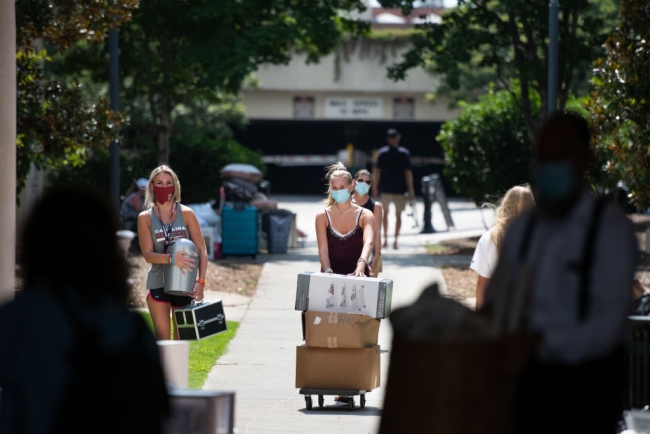You have /5 articles left.
Sign up for a free account or log in.

Sean Rayford/Getty Images
This fall term, though it has barely begun, has been one of the most chaotic in decades for colleges and students.
Many colleges and universities around the country have changed their plans for in-person classes days before -- or even after -- the term has begun. Some have brought students back to campus, only to quickly struggle with outbreaks and infections.
The University of Notre Dame and the State University of New York at Oneonta, for example, both offered some in-person instruction for the fall term. Now students have been learning remotely from their residence halls due to campus outbreaks.
Butler University told students classes would be in person as well, but the university switched to remote learning one day before the start of the term.
Three colleges in the University of North Carolina system -- Chapel Hill, North Carolina State University and East Carolina University -- brought students to campus only to send them back home within a month.
Some colleges that promised a safe and healthy semester have seen more than 1,000 of their students infected. Some students have speculated on social media that their institutions are waiting until withdrawal or refund deadlines pass to pull the plug.
It’s clear that many college leaders are on a roller coaster, with students along for the ride.
Research has shown that students vastly prefer a semester in person, with some saying they would be unlikely to return for remote learning. But whether students and families will continue to trust institutions that have brought them to campus, only to send them back and forth across the country, lock them in their dorms, or allow them to get sick, remains to be seen. Observers say students may end up feeling that their colleges were less than honest.
The most recent polling, conducted in early August, shows that most students then believed their institutions were looking out for them and handling the situation well.
A public opinion poll from Third Way and New America, supported by Global Strategy Group, found that 75 percent of college students believed their institutions had students’ best interests at heart. Eighty-three percent of respondents said their institutions care about student health and well-being. (However, 69 percent of students also said institutions generally are looking out for their bottom lines more than health and safety.)
“Students have a lot of empathy for their schools in that they do not blame colleges for the circumstances. They understand that everyone is going through this and trying their best,” said Tamara Hiler, director of education at Third Way.
But, she said, retesting that metric now, after institutions have pivoted or exhibited poor communication, could find that empathy waning. Data show students already are beginning to ask questions about the value of their college education, which could translate into frustration with their institutions.
Americans on the whole have been losing faith in the value of higher education over the past few years. That development is coupled with a growing negative perception of nearly all types of U.S. institutions.
“People gave a lot of deference to their institutions this spring because it was something we were going through as a nation. They understood this is unprecedented,” said Rachel Fishman, deputy director of research in higher education at New America. “As we move into fall, the expectations are higher.”
New America also has been conducting qualitative research with student interviews. Anecdotally, Fishman said students at colleges that pivoted to a majority remote semester early in the summer, such as the California State University system, have seen more stability and have been able to plan their lives around remote learning. Students at institutions that have communicated poorly or pivoted chaotically, she said, have had waning tolerance.
Erin Hennessy, vice president for TVP Communications, a higher education-focused PR firm, said when institutions are able to show students a plan that is well communicated, thoughtful and transparent, they can maintain student trust through difficult decisions, like modality pivots.
“When it feels like these decisions are made in a chaotic way, when they seem to come as a result of public pressure, that’s when I think people start to lose faith in the institution and the decision-making process,” she said.
Colleges that bring students back to campus will be better able to deal with outbreaks if they get students used to the idea that there will be COVID-19 cases on campus, she said. As a result, they will demonstrate that the college has a plan and is able to manage and take care of those students safely.
Once students, families, faculty or staff members have lost their trust in the administration, Hennessy said, everything else the college does may be called into question. And the work to repair that trust draws time and resources away from other things the college needs to do.
“When the question of trust is put on the table, it expands exponentially to all of the other things that the institution is doing, all of the other work that the leadership needs to ensure is getting done,” she said. “Colleges and universities are with the best of intentions trying to do maybe the hardest thing they’ve ever had to do. And it’s not always going to go perfectly, because there’s no road map for this.”








